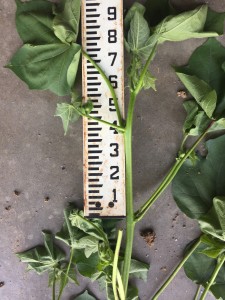Many fields in West TN reached first flower well-before the 4th. I wouldn’t be surprised if over half of our acres will be blooming by the end of the week. With rain and warm temperatures in the forecast, expect very rapid plant growth in areas which have adequate moisture as we move into flowering. For those who have not applied an early shot of a plant growth regulator (PGR), you should consider doing so very soon. Several points should be considered when attempting to regulate growth in 2016.
Fortunately, many of the varieties planted in 2016 were planted to a large number of acres in 2015. Still, I classify these as ‘new’ varieties (i.e. varieties which less than three years of data has been collected). Although we have some suggestions from industry trials as to how these varieties will respond to plant growth regulators, much of this dataset is limited to the 2014 and 2015 seasons. Keep in mind that 2016 is a very different year than either 2014 or 2015 and we do not have data on most of these varieties from a more ‘normal’ year- like the one we are currently experiencing. The table below represents our best guess as to how these varieties will respond. Classification is based on determinacy (more determinate varieties are typically more responsive and indeterminate varieties are commonly less responsive), growth habit (more vigorous varieties will require more and are therefore considered less responsive) and direct response to the regulator (variety sensitivity is largely influenced by the aforementioned factors, but specific response can vary independently based on plant response to the regulator).
| Very Responsive | Responsive | Moderately Responsive | Least Responsive | |
| DP 1518 B2XF | DP 1522 B2XF | NG 3405 B2XF | NG 3406 B2XF | PHY 495 W3RF |
| DP 1612 B2XF | PHY 312 WRF | ST 4946 GLB2 | PHY 339 WRF | PHY 490 W3FE |
| DP 1614 B2XF | DG 3385 B2XF | ST 5032 GLT | PHY 333 WRF | PHY 499 WRF |
| ST 4747 GLB2 | PHY 444 WRF | |||
The best approach to managing growth in a new variety is to use multiple applications based on plant growth measurements. Several different measurements can be used (and multiple should be considered) but the most emphasis should be placed on current growth. One of the best ways to gauge current growth is to measure the internode length between the fourth and fifth nodes.
If the distance between fourth and fifth node is:
- Less than 2”: Growth not adequate. Application is not warranted.
- Between 2” to 3”: Growth is adequate; a low application may be warranted on ‘strong’ ground, but applications in this range are not universally warranted.
- Exceeds 3”: Growth is excessive. The potential for rank growth is high and an application should be strongly considered.

Monitoring the internode length between the fourth and fifth nodes can give insight into current growing conditions. The pictured plant has an internode length of 3+” and justifies a PGR application.
Additional thoughts:
- The main goal is to use PGRs to govern vegetative growth until the reproductive sinks begin to naturally govern vegetative growth. Given fruit retention is adequate, the transition to reproductively governed vegetative growth should occur during the effective flowering period.
- PGRs do not shrink the plant; instead, they ultimately reduce internode elongation (among other things). Although yield increases due to PGR applications are not consistent, PGRs consistently increase the penetration of insecticides into the canopy and increase harvest efficiency.
- If applied during a stress (particularly drought stress) or immediately prior to the onset of stress, yields can be negatively affected. Many fields are relatively dry at the moment. If under drought stress, applications should be delayed until stress has been remedied through a rainfall or irrigation event.
- Several PGRs are currently available, but results of a regional Beltwide study noted no significant differences in effectiveness of formulations of mepiquat chloride, mepiquat chloride + kinetin, mepiquat chloride + cyclanilide, and mepiquat pentaborate when used at equivalent rates (Dodds et al., 2010).
- If applying a standard mepiquat chloride (0.35 lb ai per gallon) product to flowering cotton which has not yet received a PGR application, rates should vary from 4-8 ounces on very responsive varieties planted on thin ground to 12-16 ounces on least responsive varieties planted in areas prone to grow ‘rank.’ Again, keep in mind applications during periods of stress can reduce yields.


